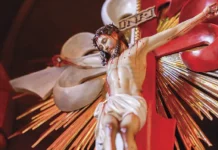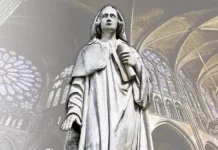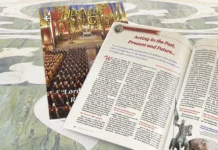Is it a rule of history or a mysterious coincidence? What is certain is that the fall and ruin of especially symbolic buildings or cities is usually an eloquent sign of radical changes in the course of events.
Humanity has been constructing for millennia. In fact, it is hard to pinpoint the origin of architecture, since buildings have always been an essential part of human life.
From the most elementary and rustic monuments of prehistoric peoples to the colossal Egyptian pyramids – royal tombs housing the mummies of the pharaohs1 –, from the sumptuous temples rising above the Greek acropolis to the immense cathedrals of medieval Europe, architecture is perhaps the art that most clearly expresses the aptitudes, knowledge and needs of a people.
Constructed for housing, religious worship, work or study; for health care or even the practice of sport, buildings are indispensable, and life without them is inconceivable.
But even in this matter, there is something that transcends the practical.
The symbolic character of buildings
In Genesis, a few chapters after the account of the flood, we read how men organized themselves to carry out an immense project:
“Come, let us build ourselves a city, and a tower with its top in the heavens” (Gn 11:4). This initiative displeased the Most High because it was based on vainglory and rejection of Him. And did not Babel come to represent disobedience to the Lord and wretched human self-sufficiency?
Further on, God himself will bury the cities of Sodom and Gomorrah under fire and brimstone (cf. Gn 19:24-25) because of their abominations, making them a symbol, for future centuries, of the sin they practised.
But in an opposite sense, edifices can also reflect sublime realities. It was not without reason that the Apostle uses the image of a temple when speaking of the members of the Mystical Body of Christ:“You are fellow citizens with the Saints and members of the household of God, built upon the foundation of the Apostles and Prophets, Christ Jesus himself being the cornerstone, in whom the whole structure is joined together and grows into a holy temple in the Lord” (Eph 2:19-21).
And St. John will take the figure of a “new Jerusalem” in the Book of Revelation to express his vision, entirely mystical and shrouded in mystery: “Then I saw a new heaven and a new earth […]. And I saw the Holy City, new Jerusalem, coming down out of Heaven from God, prepared as a bride adorned for her husband” (Rv 21:1-2).
Few cities in the world would become as emblematic as Jerusalem. It was the symbol of the unity of the Chosen People, who always held it in the greatest esteem: “If I forget you, O Jerusalem, let my right hand wither! Let my tongue cleave to the roof of my mouth, if I do not remember you, if I do not set Jerusalem above my highest joy!” (Ps 137:5-6). The Holy City went on to represent, among other attributes, the unity of the Catholic Church itself.2
Thus, certain buildings acquire a truly symbolic character according to the circumstances in which they are erected, used or destroyed.
A radical change in Israel’s panorama
For the famous historian Daniel-Rops, “the evolution of human societies are not subject to abrupt breaks and, from the past to the future, changes are more often brought about through transformation than by sudden mutation.”3 This, however, does not eliminate the existence of fateful dates, “when it seems that the current of history itself changes course.”4

Whether for small regions or great civilizations, such dates do exist and many of them are highlighted by the fall and ruin of buildings or entire cities, heralding radical changes in events. The conquest of Jerusalem in 70 AD illustrates this well.
In the Zion of old, the Temple was the pride of the Hebrew nation. However, it collapsed twice. The first time was when the city was conquered by Nebuchadnezzar, king of Babylon (cf. Jer 42-43). The building erected by Solomon was rebuilt between the reigns of Cyrus and Darius (cf. Ezr 6), being consecrated around 515 BC. In 70 AD, however, it suffered the tragic episode that would culminate with its definitive ruin.
At Passover of that year, Rome decided to put an end to the successive Jewish revolts. So the Emperor Vespasian sent his son Titus to Jerusalem with all the necessary armies and war machines:
“Five months later, after unspeakable scenes of horror, the siege came to an end. Jerusalem lay in ruins, thousands of corpses rolled under the hooves of the Nubian horsemen in the service of Rome.”5
And what of the Temple? It had been burned, against the will of Titus himself, who had ordered its preservation.
The Jewish historian Flavius Josephus affirms, with a touch of patriotic exaggeration, that it was the destruction of the most splendid work that had ever existed on earth, owing both to its structure, magnificence and wealth, and to the sanctity it housed. It is also impressive that the destruction of this incomparable Temple took place on the same day and in the same month that the Babylonians had burned it down.6
A terrible symbol of the disgrace that had befallen Israel, the loss of the Temple and the conquest of Jerusalem was a turning point in the history of the Hebrews. For them, life would no longer be the same: “Of the Jewish resistance only a few insignificant groups remained, hidden among the rubble, and they succumbed in the following years. Judea became a Roman province, separated from Syria and occupied by a legion quartered in Jerusalem. The Sanhedrin and the high priesthood disappeared.”7
Fall of Byzantium, end of the Middle Ages
Many centuries later, another major city would fall. Another page of history was turned.
It was the year 1452. Attempts to reunite the Church after the Great Eastern Schism of 1054 remained futile. “It is better that the turban of the Turks reign in Constantinople than the mitre of the Latins,”8 the high dignitaries of Byzantium publicly exclaimed to the applause of the crowd. And so it came to pass.

A year after the above declaration, the troops of Mohammed II pillaged the great city. In the Basilica of St. Sophia, “thousands of Christians who had taken refuge there to pray were all beheaded. More than fifty thousand Greeks of both sexes and of all ages were sold into slavery. […] Invaluable treasures of art and intellect were plundered and senselessly destroyed: statues, rare columns, religious ornaments, manuscripts and Evangeliaries […].
“Finally, in St. Sophia, whose walls had been whitewashed with plaster to obliterate the figures hated by the Koran, the victor made his solemn entrance, recited the Muslim prayers and, with a word, declared the massacre over. More than a thousand years of Christian grandeur had come to an end.”9
For most historians, the events of 1453 in Byzantium mark the end of the Middle Ages.
Is there any other such event that can be considered a symbolic milestone?
Pusillanimity brings down a fortress
Let us look to the Kingdom of France on July 14, 1789.
If a novelist had dared to imagine what happened that day in Paris, he would have run the serious risk of being branded a madman and a conspirator. But this was not fiction. History itself took charge of painting a tragic succession of horrors in colours of glaring reality.

The armed crowd flocked around the Bastille fortress. Shooting incessantly and trying to set fire to one of the towers, they finally succeeded in breaking the moorings of the drawbridge, which violently collapsed. The courtyard was overrun and the buildings ransacked. The crowd, drunk with blood, rushed to the Council Chambers. Flesselles, the mayor of the municipality, came forward, ashen, to meet them. He had not yet taken three steps when, in his turn, he was killed and beheaded.10
That ancient medieval fortress had been transformed into a government prison, which held only seven prisoners at the time: four forgers, a young man arrested at the request of his family, and two madmen. In taking the Bastille, the revolutionaries were in search of the armaments and ammunition deposited there. The fortress itself was of no great importance; its conquest, however, was extolled by the propagandists, praised by the Assembly, approved by the court, and legitimized by Louis XVI. It became the sign of royal pusillanimity and the “proof that the monarchy renounced its own principles.”11
The storming of the Bastille has become one of the greatest symbols of the French Revolution. Why? The people attacked with the intention of seizing weapons, it is true. But the episode had a deeper dimension: the castle was a symbol of the regime they wanted to destroy. Thus its ruin represented the collapse of the monarchy, which had hitherto been on this earth “the supreme remedy against the wickedness of men and hostile events.”12
New reference point for the world
Other eloquent facts can be mentioned, such as the bombing of European cities in the First World War. That conflict reduced various parts of Europe – once the “centre of the world” to rubble – while on the other side of the Atlantic new winds of progress were blowing.

Prof. Plinio Corrêa de Oliveira, having witnessed these transformations in the world panorama, would write: “Before the splendour of the young and gigantic American nation, Europe, beautiful, conservative and respectable, but crushed by the war, seemed to have been relegated to retirement by the facts and unable to solve its problems, except insofar as the colossus would help it. A continent with an aura of past glories, it is true, but incapable of mastering the present and, above all, of producing the future. The land of lovely things and fairy tales, having lost its raison d’être, was being replaced by a new power.
“World public opinion suddenly realized that its own axis had shifted: Europe had once been the centre of attention, but now the world offered another reference point.”13
But this new model would suffer a mysterious blow at the dawn of the third millennium.
The greatest terrorist attack in history
“A dark day in the history of humanity,” is how the Supreme Pontiff described that September 11, 2001.14
At 8.45 a.m., New York time, an aircraft hijacked by terrorists crashed into one of the largest buildings in the world. Eighteen minutes later, the building adjacent to the first was struck by another plane. When the clock struck 10:30 a.m., the twin towers of the World Trade Center – 110-story high buildings – had been razed, reduced to iron and concrete rubble.
About forty minutes after the first explosion, a third plane struck the Pentagon, headquarters of the American Department of Defense; and at 11:29 a fourth plane crashed outside Pittsburgh (Pennsylvania). The disasters claimed thousands of victims.15
The ruthless terrorism, condemned by all international authorities, was not without its highly symbolic aspect. According to the then-Chancellor of Germany, Gerhard Schröder, the attacks were a “declaration of war on the entire civilized world.”16
One columnist remarked: “A new page of history [has begun]. […] The verdict is conclusive: the world is entering new and odious terrain.”17
Leaving aside the political and economic issues surrounding the fact, does not an event of these proportions, at the dawn of a new century, a new millennium, have grave implications?
The destiny of a civilization given over to sin
It is clear that in a world based on morality and God’s law, there would never be room for atrocities of this kind. Daniel-Rops very accurately states: “The crises that shake human societies always begin as spiritual crises; political events and social upheavals merely translate into events an imbalance whose cause is much deeper.”18

Now, would not the “deep-seated cause” of occurrences like this be closely related to that contempt for God and the erroneous human criteria that John Paul II spoke of in his visit to Fatima?19
The world has closed itself off from the Most High and seems to reap the fruits of the disorder it has sown in sin and iniquity. Indeed, it was in this regard that Our Lady warned humanity, through the shepherd children, when She called for an urgent conversion of hearts. But not even this maternal warning found an echo in souls.
Now, what results could be expected from this rejection of the will of God and of Our Lady, if not the worst disasters?
The terrible events that opened the 21st century almost twenty years ago may well be eloquent symbols of the destiny of a civilization that wants to wallow in sin. Perhaps the forces of hell rejoiced with the fall of the Twin Towers, foreseeing the advent of an era in which they would advance, as never before, to consummate the perdition of a world that they intend to dominate.
Incidentally, recalling those scenes of horror, we cannot help but remember the raging flames that have consumed so many churches around the world in recent years, especially the incomparable Notre Dame Cathedral in Paris.
In any case, such ungodly flames must not be seen as a presage of the triumph of hell. When the demons least expect it, Jesus himself will bring down, with a single breath (cf. 2 Thes 2:8), the “Babel” built by the devil and his followers. Then we will see whose hands are holding the true “reins” of events! ◊
Notes
1 The Egyptians affirm that “the house was a place of passage, but the tomb, an eternal mansion” (cf. AYERVE, CMF, Francisco Naval. Curso Breve de Arqueología y Bellas Artes. 8.ed. Madrid: Coculsa, 1950, p.106.).
2 Cf. JERUSALEM BIBLE. São Paulo: Paulus, 2016, p.998.
3 DANIEL-ROPS, Henri. História da Igreja de Cristo. A Igreja da Renascença e da Reforma. São Paulo: Quadrante, 1996, v.I, p.104.
4 Idem, ibidem.
5 DANIEL-ROPS, Henri. História da Igreja de Cristo. A Igreja dos Apóstolos e dos mártires. São Paulo: Quadrante, 1988, p.51.
6 Cf. JOSEPHUS, Flavius. História dos Hebreus. São Paulo: Américas, 1963, v.VIII, p.295.
7 DANIEL-ROPS, História da Igreja de Cristo. A Igreja dos Apóstolos e dos mártires, op. cit., p.52-53.
8 DANIEL-ROPS, História da Igreja de Cristo. A Igreja da Renascença e da Reforma, op. cit., p.92.
9 Idem, p.96.
10 Cf. GAXOTTE, Pierre. A Revolução Francesa. Porto: Tavares Martins, 1945, p.92-93.
11 Idem, p.94.
12 Idem, ibidem.
13 CORRÊA DE OLIVEIRA, Plinio. Notas Autobiográficas. São Paulo: Retornarei, 2010, v.II, p.63.
14 ST. JOHN PAUL II. General Audience, 12/9/2001.
15 Cf. EDITORIAL. Um país em estado de choque. In: O Estado de São Paulo. Ano CXXII, N.39411 (12 set., 2001), p.A1; A4.
16 Cf. MUNDO CONDENA E PEDE UNIÃO CONTRA O TERROR [WORLD CONDEMNS AND CALLS FOR UNITY AGAINST TERROR]. In: O Estado de São Paulo, op. cit., p.A14.
17 LAPOUGE, Gilles. Violência, sem precedentes, abala a história. In: O Estado de São Paulo, op. cit., p.A11.
18 Cf. DANIEL-ROPS, A Igreja da Renascença e da Reforma, op. cit., p.106.
19 ST. JOHN PAUL II. Homily for the Mass in Fatima, 13/5/1982.







